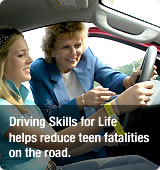
Volvo's Child Booster Cushion System.
Click here for more on Volvo.
November 26, 2007 -- The innovative Child Booster Cushion System from Volvo Cars has been honored with a Best of What's New 2007 award by Popular Science Magazine. The annual awards salute significant innovations in a number of areas of technology.
Volvo Cars new integrated 2 stage booster seat helps protect children who have outgrown their toddler seat. This integrated 2 stage booster cushion in combination with the extended Inflatable Curtain, and load limiting seat belts is a world first and recently received international acknowledgement as a unique engineering solution to give children of different size a safe and comfortable travel experience.
Chosen from thousands of new products and innovations, and selected as 1 of 100 best new technologies for 2007, Volvo Car Corporation, LLC, received Popular Science's annual Best of What's New award for this child protection system. A similar design was first shown in 2001 aboard Volvo's Safety Concept Car as a concept that would provide better seat belt positioning for children. Subsequent refinements to the seat, vehicle side body structure, seat belt attributes, and inflatable side curtain culminated with launching Volvo's newest crossover estate, XC70 in Geneva Motor Show in Switzerland this past March.
Earlier this year, Volvo Cars received an award from the World Traffic Safety Symposium at this year's New York International Auto Show. The award was for best new safety feature in an automobile.
Volvo Cars prides itself in finding innovative ways to advance automobile safety.
"Our goal is to help protect occupants. This award acknowledges our efforts to help protect our smallest passengers, our children," commented Thomas Broberg, Senior Safety Advisor, Volvo Car Corporation, Sweden. "This new seat, in conjunction with our refinements in side body structure, the load limiting seatbelts and the inflatable curtain will provide children of different sizes with effective protection in a side impact.
Safety Potential Prediction
Seat belt positioning for children of different heights is important for better placement and protection. Several studies have shown that proper positioning with the use of a booster cushion helps reduce abdominal injuries caused by the child slipping under the seat belt. Field data in several studies supports these findings and emphasizes the importance of booster seats, and that the booster helps to hold the belt firmly across the pelvis or thighs during a frontal impact. The overall effectiveness (Measured Abbreviated Injury Scale 2+) of booster seats is estimated as 31 percent as compared to using only a seat belt and as high as 75 percent as compared to no restraint at all. Getting all children of appropriate age and size to use booster cushion offers a potentially significant safety benefit.
Booster Cushion Usage
For children using a booster cushion different types of misuse varies depending on which study is analyzed, but the share is significant. According to a study carried out by National Highway Traffic Safety Administration (NHTSA, 2004), 39.5 percent of the 664 children inspected in belt-positioning booster cushion were considered as critical misuse. The most common occurring misuse was improper fitment of the shoulder belt followed by loose belt, improper fit of the lap belt and inappropriate age/fit. In Germany, the misuse rate was reported to be 46.8 percent. A Spanish study identified that nearly 50 percent of the children aged 6 to 12 restrained with a child restraint had some type of misuse, the most common being the seat belt placed behind the child.
Children's Attitudes Toward Booster Cushion
A questionnaire-based study on 4 to 11 year old Australian children reported that one of the reasons for moving the child from a booster to the adult seat belt only (69 percent) was primarily that the child was too big for the booster. Another major reason was the child disliked sitting in a booster and would be more comfortable using only the seat belt and, not surprisingly, the child thought they were too 'grown-up' for a booster cushion. The study concluded that the design of booster cushions should have the capacity to seat larger children as well as being more appealing to children. By offering the integrated two-stage booster cushions, Volvo believes the level of acceptance will increase among this age group.
Combined Safety System
"We took into account the child's physical size and weight, seat belt misuse, child physiology, along with redesigning our vehicle side body structure and side impact inflatable curtain to come up with this new integrated two-step booster seat," noted Broberg. "There will be better fitment of our three-point seat belt, a wider age and weight range, and better attitude for the child who can now easily see outside with the added benefit of reducing driver distraction. Hopefully we will hear less often: 'Are we there yet?'"
Vehicle Option
This new child safety feature is available for the all new V70 and XC70 crossover estate. This option includes two rear-seat mounted integrated booster seats and two pyrotechnically pretensioned seat belts with new load limiters to accommodate children using this booster cushion and normally positioned adults. Both seats fold flat to expand the cargo compartment and are indistinguishable from rear seats without this option.
Specifications
The upper setting is designed for children measuring 95-120 cm and weighing between 15 and 25 kg, while the lower setting is intended for children between 115-140 cm height and weighing between 22 and 36 kg.
1 Charlton J, Koppel S, Fitzharris M, Congiu M, Fildes B. Appropriate Use of Booster Seats and Seatbelts by Australian children Aged 4-11 Years. 4th Int. Conf. Protection of Children in Cars, München, Germany, 2006

